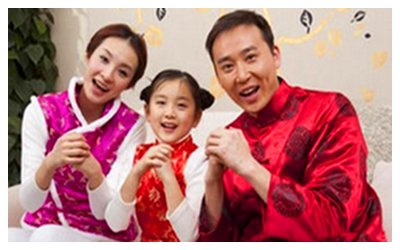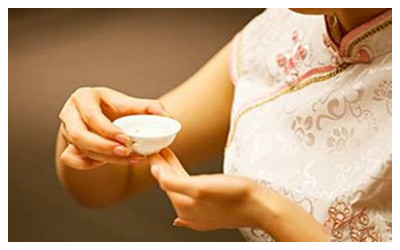
Chinese Day-life Etiquette
Walking Etiquette
Walking etiquette is required as knowledge for people when they’re walking. There is an etiquette since ancient times where people in a lower class stoop when passing by people in the upper class to show their respect. Walking etiquette follows the principle that people should not walk in the middle of the road along the two sides of the road and should not stand in the middle of the door. This not only indicates reverence, but allows others to pass.
Greeting etiquette
People show hospitality and courtesy when meeting others. There are various rules when meeting with people of different identities. For example, people often make the fist-and palm salute in daily greetings as it was the most common etiquette used when meeting people.
 The fist-and-palm salute: The fist-and-palm salute, also called “zuoyi” in Chinese, is not only a symbol of appreciation and reverence, but also a type of greeting in China. Beginning in the Western Dynasty (11century - 771BC) as a greeting and association, the fist-and-palm salute has been active for over three thousand years of history. Ancient people in China paid salute to one another as a routine etiquette and presentation of modesty. Chinese people show respect for others through keeping their distance, rather than physical intimacy like westerners. This kind of distance is not only a display of elegance, but also in line with modern hygiene. Many experts that study this ritual believe that the fist-and-palm salute is a greeting that can best symbolize the spirit of China.
The fist-and-palm salute: The fist-and-palm salute, also called “zuoyi” in Chinese, is not only a symbol of appreciation and reverence, but also a type of greeting in China. Beginning in the Western Dynasty (11century - 771BC) as a greeting and association, the fist-and-palm salute has been active for over three thousand years of history. Ancient people in China paid salute to one another as a routine etiquette and presentation of modesty. Chinese people show respect for others through keeping their distance, rather than physical intimacy like westerners. This kind of distance is not only a display of elegance, but also in line with modern hygiene. Many experts that study this ritual believe that the fist-and-palm salute is a greeting that can best symbolize the spirit of China.
If you are a foreigner, you will feel the passion from this greeting and may return this to someone else as a sign of respect. The gesture of the fist-and-palm salute is: first standing and then cupping one hand in the other before the chest, showing politeness. If people pay a visit to others, the host and guest should ask one another to be seated first by bowing with hands clasped, hands rising high and lowering repeatedly, at the same time, lowering the head and leaning the body forward slightly. Other than these occasions, bowing with a hand folded in front is seen when people make an appreciation, congratulate, apologize or ask for assistance. It is also done when people in a higher class return a gesture to the people in the lower class. There is etiquette for the most revered person in the society, which is done by kneeling down with hands and head touching the floor.
Today, however, this is only found when people visit the remote countryside around New Year’s. People are accustomed to shaking hands, which is a kind of etiquette introduced from western countries used to introduce oneself.
Seating etiquette
The seating etiquette is organized, which varies among people of different classes. People in the highest class are placed in the most honorable seats, while those in the lowest class sit further away. There are rules according to what class a person is placed in that determines where they sit. It would disappoint the host if you were to sit in the wrong seat and would be considered impolite. If you aren’t sure where to sit you should ask the host. For indoor seats, those facing the east are honorable, while seats facing the west are not. Seniors are often seated in the southward seats, known as north seats, while the younger generation is placed in northward seats, known as south seats. During a meal it is important that the body is close to the table. In contrast, when you stop eating you must move away from the table. The people around the table should immediately stand up to give regards to the respected people at the table.
Dining etiquette
Dining etiquette plays an important role in Chinese society. In the Qing Dynasty, it was a custom for people to entertain guests with a hearty meal, leaving courteous behavior to the descendants when dining and drinking together. People will host a dinner on the arrival of a guest to welcome them and have a farewell dinner when the guest leaves. Alcohol is necessary in welcoming and sending off guests in Chinese culture. An old saying goes, “no alcohol, no protocol.” Etiquette also exists when toasting at a banquet. For example, the guest should not drink until the host proposes a toast and advises them to drink, which is known to many in the saying such as, “drinking with others, never drink first.” If the guest wants to give appreciation to the host for his hospitality, he or she can toast the host. During a meal, it is also a symbol of politeness for the guest to wait to eat until the host does. This is known by the saying, “dining with others, never to taste first.” There are a series of dining rules including, “not sighing at the table, not to be full with a shared meal, not to use your hands during a meal,” and “never throw bones to the dog,” among others. The guest and host should respect each other to create a harmonious dining atmosphere.
Etiquette in celebrations and condolences
Since ancient times China has been considered as a society of human relationship, where people take care of each other and many ceremonials and rules have been developed. Celebration etiquette, particularly during festivals and celebrations are important. When people worship or express their gratitude, they should not only be respectful, reciting congratulations while bending, but also offer a congratulatory gift. People will undergo various periods of life including, birth, adult, wedding, birthday-celebration and death, etc. throughout history people in China have a set way of behaving at different events in life.
In a feast celebrating the first month of a newborn baby, the relatives and friends go to congratulate and bring nutritious food and clothes or shoes to the baby. While the baby is growing up, there is a coming-of-age ceremony; the “capping and hairpin ceremony” in ancient China refers to the male being given a capping ceremony and a new name at 20. This ceremony indicated they were qualified to marry and face society. Simultaneously, the female is given a hair-pinning ceremony at 15 symbolizing the age of marriage...More Read:
Chinese Traditional Marriage
The modern coming-of-age ceremony is held at 18, the schools will conduct collective adult oath-taking ceremony, emphasizing adult consciousness. Society attaches importance to the wedding as it is a great event in one’s life. In the wedding there are 6 procedures that are called, “the six rituals of the Duke Zhou.” First, the bridegroom makes a proposal with betrothal gifts, followed by the second, inquiring the girl’s name, the third, divining auspice, the fourth, sending nuptial gifts to the bride’s family, the fifth, asking the bride to decide the wedding date and finally go to the bride’s home to escort the bride to the wedding. In the Song Dynasty, the six rituals were simplified to three which are the first, fourth and last steps. The most significant part of the wedding is when the bridegroom goes to the bride’s home and escort her to the wedding ceremony, where she’ll pay ceremony to Heaven and Earth, and also to their parents. Then, at the bridal’s chamber at the end of ceremony they’ll continue the ceremony of toiling up a strand of hair cut from both of bride and bridegroom and drinking “cross-cupped wine.” On the wedding day, as the relatives and friends come to congratulate the newlyweds, the host will hold a large dinner... More Read: Chinese Traditional Wedding Chinese Traditional Marriage
The birthday ceremony (for an elderly person) is held after they turn 40. On that day people will have a birthday celebration, relatives and friends will come to congratulate them with gifts. The last ceremony in one’s life is their funeral which is a ceremony everyone will have. Chinese people put emphasis on death so the etiquette is important during the funeral. It is deemed auspicious when people die of natural causes, where people come with elegiac couplet, large elegiac scroll and cash gifts, showing their condolence and sadness. The dead are placed in the coffin and buried within three to five days. The etiquette in celebrations and funerals symbolize the spirit of mutual support as well as the unification of the society...More Read: Chinese Funeral Customs
The spirit of etiquette is to love people and the principle is to be modest and respect others. Only when individuals keep a low profile and treat others with humility and respect, can people be respected by others. If people with higher class lower themselves to associate with those in the lower class, society will be more harmonious. There is a common saying that, “to be good, to be modest.” Respecting others is not indicative of being courteous or paying a formal salute, but respecting one another. Otherwise, the etiquette is superficial and not consistent with the standard of decorum. The etiquette customs of respectfulness and modesty, and the etiquette principle of good moral character are advocated in modern society.
The principle of serving tea
 One important Chinese custom is to serve tea to guests. Qi Shi Zhu, the emperor of the Southern Dynasties, and Lu Na, etc., advocated the substitution of tea for wine. In the Tang Dynasty, Tang Zhenliang created the “ten virtuous of tea,” claiming the tea can not only keep fit, but also “express one’s regard to others,” “sublime one’s personality” and “cultivate one’s conducts.” In the Tang and Song Dynasties, many scholars were fond of drinking tea and described tea in their pieces.
One important Chinese custom is to serve tea to guests. Qi Shi Zhu, the emperor of the Southern Dynasties, and Lu Na, etc., advocated the substitution of tea for wine. In the Tang Dynasty, Tang Zhenliang created the “ten virtuous of tea,” claiming the tea can not only keep fit, but also “express one’s regard to others,” “sublime one’s personality” and “cultivate one’s conducts.” In the Tang and Song Dynasties, many scholars were fond of drinking tea and described tea in their pieces.
The basic principle of serving tea is to present the guest with a cup of hot tea as soon as they step into the house. You are also supposed to ask the guest’s preference before the tea is served. As the old proverb goes, “wine should be served full while tea half.” People should pay attention not to fill the cup with eight points as advised. The temperature of the tea is generally mild to prevent scalding. The tea has a homogeneous color and matches with the tea tray, while the person carries it the tea tray with the left hand holding the bottom while the right hand holds the edge.







 Ask Questions ?
Ask Questions ?